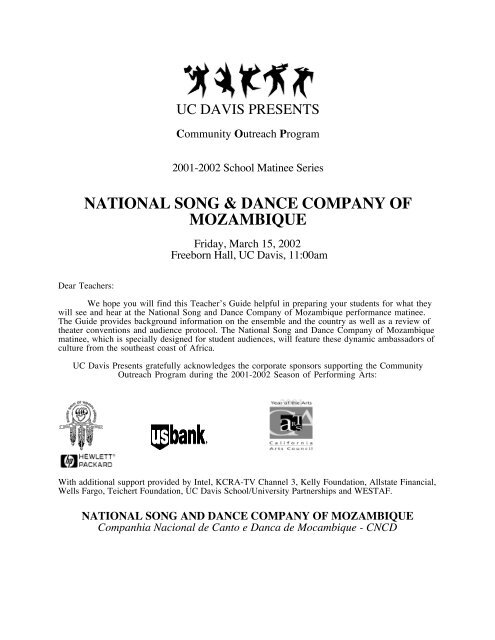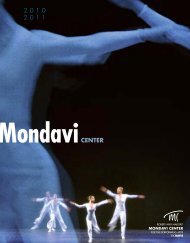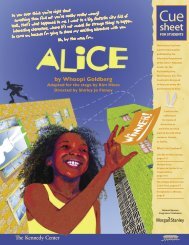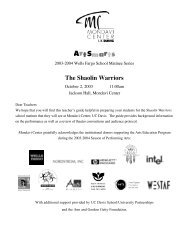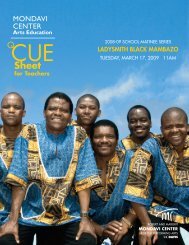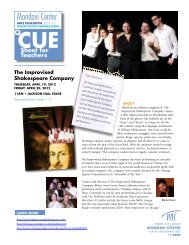National Song and Dance Company of Mozambique
National Song and Dance Company of Mozambique
National Song and Dance Company of Mozambique
You also want an ePaper? Increase the reach of your titles
YUMPU automatically turns print PDFs into web optimized ePapers that Google loves.
UC DAVIS PRESENTSCommunity Outreach Program2001-2002 School Matinee SeriesNATIONAL SONG & DANCE COMPANY OFMOZAMBIQUEFriday, March 15, 2002Freeborn Hall, UC Davis, 11:00amDear Teachers:We hope you will find this Teacher’s Guide helpful in preparing your students for what theywill see <strong>and</strong> hear at the <strong>National</strong> <strong>Song</strong> <strong>and</strong> <strong>Dance</strong> <strong>Company</strong> <strong>of</strong> <strong>Mozambique</strong> performance matinee.The Guide provides background information on the ensemble <strong>and</strong> the country as well as a review <strong>of</strong>theater conventions <strong>and</strong> audience protocol. The <strong>National</strong> <strong>Song</strong> <strong>and</strong> <strong>Dance</strong> <strong>Company</strong> <strong>of</strong> <strong>Mozambique</strong>matinee, which is specially designed for student audiences, will feature these dynamic ambassadors <strong>of</strong>culture from the southeast coast <strong>of</strong> Africa.UC Davis Presents gratefully acknowledges the corporate sponsors supporting the CommunityOutreach Program during the 2001-2002 Season <strong>of</strong> Performing Arts:With additional support provided by Intel, KCRA-TV Channel 3, Kelly Foundation, Allstate Financial,Wells Fargo, Teichert Foundation, UC Davis School/University Partnerships <strong>and</strong> WESTAF.NATIONAL SONG AND DANCE COMPANY OF MOZAMBIQUECompanhia Nacional de Canto e Danca de Mocambique - CNCD
David Abilio, General DirectorJulio Arm<strong>and</strong>o Matlombe, Artistic DirectorDANCERSRosa Domingos ~ Perola Jaime ~ Emelva Dine ~ Maria Jose ~ Liria Rafael ~Elisa Jopela ~ Julieta Simiao ~ S<strong>and</strong>ra Mahumane ~ Sheila Masungue ~Graca TimbaneGuerra Andre ~ Joao Antonio ~ Alex<strong>and</strong>re Coane ~ Zacarias MahumaneAbacar Mulima ~ Luis Sala ~ Hussene Ussene ~ Pedro Vumba ~ Justino ZimbaMUSICIANSEduardo Durao ~ Rol<strong>and</strong>o Alex<strong>and</strong>re ~ Bernabe Fundi ~ Amos Mawaia ~Arnaldo NhassengoRenowned for their luminous costumes, technical polish, creative panache <strong>and</strong> seeminglyinexhaustible energy, the <strong>National</strong> <strong>Song</strong> & <strong>Dance</strong> <strong>Company</strong> <strong>of</strong> <strong>Mozambique</strong> is one <strong>of</strong> Africa’sgreatest cultural treasures. Under the direction <strong>of</strong> dancer/choreographer David Abilio, the 25-member company presents more than 300 performances each year. The company became one <strong>of</strong>the first government-funded cultural organizations to appear after <strong>Mozambique</strong>’s independence in1975, its major goals being to collect, preserve, <strong>and</strong> perform the major expressive art forms <strong>of</strong> theMozambican people. Drawing upon the rich <strong>and</strong> diverse culture <strong>of</strong> the country, the company’srepertoire ranges from traditional dances, with choral <strong>and</strong> instrumental music, to modern African
allet, accompanied by poetical recitation <strong>and</strong> storytelling. “In our music <strong>and</strong> dance [there is] verydeep significance, there is not only the case <strong>of</strong> aesthetics or entertainment,” Abilio said. “We havesomething very deep to say through the dance. We are telling a story about Africa.”In 1979, just four years after <strong>Mozambique</strong> won its independence from Portugal, a group <strong>of</strong>young talented performers (dancers, musicians, actors, storytellers) joined to form an amateur dancetroupe in <strong>Mozambique</strong>’s capital city <strong>of</strong> Maputo, under the auspices <strong>of</strong> the <strong>National</strong> Directorate forCulture. In 1983, the group became pr<strong>of</strong>essional <strong>and</strong> was renamed Companhia Nacional de Cantoe Danca (CNCD). Artists were recruited from among the best performers in each <strong>of</strong> the nation’sten provinces <strong>and</strong>, at least once a year, they are sent to several parts <strong>of</strong> the country to learn newdances <strong>and</strong> songs that are incorporated into the company’s repertoire. The pr<strong>of</strong>essionalization <strong>of</strong>the ensemble was in recognition <strong>of</strong> its outst<strong>and</strong>ing contribution to the promotion <strong>of</strong> national culture,with the government pledging to provide for better working conditions <strong>and</strong> financial <strong>and</strong> technicalsupport, <strong>and</strong> to ensure ever higher performance st<strong>and</strong>ards. Today, the <strong>National</strong> <strong>Song</strong> <strong>and</strong> <strong>Dance</strong><strong>Company</strong> <strong>of</strong> <strong>Mozambique</strong> is composed <strong>of</strong> about 50 members, including dancers, musicians,technicians, <strong>and</strong> administrative staff.Each year, the company’s season includes performances in the capital city <strong>and</strong> in a number<strong>of</strong> towns <strong>and</strong> villages around the country <strong>of</strong> <strong>Mozambique</strong>, reaching an audience <strong>of</strong> over 300,000.An unprecedented phenomena was undoubtedly the presentation throughout the country <strong>of</strong> “Odeto Peace,” an artistic program for civic <strong>and</strong> electoral education financed by the European EconomicCommunity. From 1993 to 1994, the dance company toured this program to all provincial capitalsas well as to 70 districts reaching more than 2,000,000 spectators. The company has regularlytoured abroad, winning universal acclaim <strong>and</strong> enthusiastic reviews from critics. In addition tovisiting more than ten countries in Africa, the troupe has toured to Bulgaria, Hungary, Denmark,France, Spain, Sweden, Norway, Germany, Italy, Portugal, <strong>and</strong> Romania. In the Americas, CNCDhas performed in Brazil, Cuba, Guyana, Jamaica, <strong>and</strong> the United States. In Asia <strong>and</strong> the MiddleEast, the company has toured China <strong>and</strong> Dubai, <strong>and</strong> recently performed in Australia. CNCD madeits U.S. debut in the spring <strong>of</strong> 1998 with engagements at the Kennedy Center in Washington, DC<strong>and</strong> the New Jersey Performing Arts Center in Newark. In the current 2001-2002 season, thecompany tours the United States <strong>and</strong> Canada with engagements coast-to-coast during an extendedsix-week tour.
ADMINISTRATIVE BIOGRAPHIESDAVID ABILIO MONDLANE, General Director, was born in 1949 in Chibuto, a small village inthe Gaza province <strong>of</strong> southern <strong>Mozambique</strong>. The son <strong>of</strong> a king <strong>of</strong> the Makambanes tribe, he cameto settle in Maputo, the capital city, after his father’s death. In 1974, he joined a small group <strong>of</strong>young people who founded the first cultural association to represent the country, the MozambicanAssociation <strong>of</strong> Musical <strong>and</strong> Theatrical Culture. And in 1976, under the patronage <strong>of</strong> the <strong>National</strong>Directorate <strong>of</strong> Culture, he founded a performing troupe <strong>of</strong> dancers, singers, poets, <strong>and</strong> theater artists<strong>of</strong> which he became Artistic Director. It was from this group that the <strong>National</strong> <strong>Song</strong> <strong>and</strong> <strong>Dance</strong><strong>Company</strong> originated. David Abilio is also a playwright, a teacher <strong>of</strong> drama <strong>and</strong> culture, a theaterdirector, <strong>and</strong> a choreographer. His most important dances, “Em Mocambique o Sol Nasceu” <strong>and</strong>“N’tsay,” have been performed throughout the world <strong>and</strong> won many awards.JULIO ARMANDO MATLOMBE, Artistic Director, was born in 1958 in Maputo <strong>and</strong> firstjoined the <strong>National</strong> <strong>Song</strong> <strong>and</strong> <strong>Dance</strong> <strong>Company</strong> <strong>of</strong> <strong>Mozambique</strong> in 1981 as a dancer. With thecompany, he has toured to Portugal, Pol<strong>and</strong>, Russia, Brazil, Norway, Spain, Zimbabwe, <strong>and</strong> theU.S., performing during the company’s 1998 American debut at the Kennedy Center inWashington, DC. Mr. Matlombe was appointed Artistic Director in 2000. Among hisresponsibilities are auditioning, training, <strong>and</strong> rehearsing the dancers in the performance repertoire <strong>of</strong>the company. He also conducts master classes for local dancers while the company is on tour. Histraining in dance <strong>and</strong> choreography includes study in Birmingham, UK with the Kokuma <strong>Dance</strong>Theatre <strong>and</strong> attending an accelerated course <strong>of</strong> study at the Moving into <strong>Dance</strong> Academy in SouthAfrica. He has also participated in workshops given at the Alvin Ailey American <strong>Dance</strong> TheatreSchool, at the American <strong>Dance</strong> Festival, with Paul Taylor, <strong>and</strong> with Jawole Zollar <strong>of</strong> Urban BushWomen in the US.PROGRAM FOR YOUNG PEOPLEThe program for young people, called “Celebration, “ will be narrated <strong>and</strong> introduced byGeneral Director <strong>and</strong> choreographer, David Abilio. “Celebration” consists <strong>of</strong> some <strong>of</strong> the sametraditional dances incorporated into the work In <strong>Mozambique</strong> the Sun Has Risen Up. Thisextraordinary suite <strong>of</strong> dances, created in 1985 to celebrate the 10th anniversary <strong>of</strong> Mozambicanindependence, were specifically designed to affirm national solidarity, in a country where the people
speak 16 different languages. Each <strong>of</strong> the seven numbers require costume changes, yet dancersmove seamlessly from modern dance to the theatricalized forms <strong>of</strong> more traditional dances. Aspectacular extravaganza featuring the most representative songs <strong>and</strong> dances <strong>of</strong> <strong>Mozambique</strong>, In<strong>Mozambique</strong>, the Sun Has Risen Up is an engaging act <strong>of</strong> parades, flirtations, <strong>and</strong> friendly athleticcompetitions. <strong>Dance</strong>rs invite audiences to clap with the rhythm as the dances accumulate intensity,<strong>and</strong> the finale—a patriotic flag-waving celebration—expresses the joy <strong>of</strong> African liberation. “Theprogram was exhilarating in the caliber <strong>of</strong> performing <strong>and</strong> the exquisite costumes <strong>and</strong> stagedesigns,” praised the New York Times critic in a recent review; “But the greatest fascination lay inthe ways age-old traditional dance <strong>and</strong> music were filtered through a modern sensibility to producean extraordinarily vital <strong>and</strong> subtle new art.”IN MOZAMBIQUE THE SUN HAS RISEN UPEm Mocambique, o Sol Naceu(1985)TUFU/ NSSOPE, a dance from the northern coast <strong>of</strong> <strong>Mozambique</strong>. Before Portuguese colonialoccupation, Arab traders had settled in the coastal zones <strong>of</strong> <strong>Mozambique</strong> in the course <strong>of</strong> theirexpansion throughout Africa. They left religious <strong>and</strong> cultural influences through the contact thatthey had with the population. <strong>Dance</strong>s performed by women at celebratory event reflect thisinfluence.XIGUBO, a dance from southern <strong>Mozambique</strong>. Traditionally, the Xigubo was performed tocelebrate military victories <strong>and</strong> to prepare warriors for battle. The dancers dress as if for battle <strong>and</strong>br<strong>and</strong>ish their weapons, their steps <strong>and</strong> movements representing the various stages <strong>of</strong> war. Drums<strong>and</strong> gululas keep the beat. <strong>Song</strong>s to encourage the warriors are chanted throughout. This dancewas brought to <strong>Mozambique</strong> in the 19 th century by Nguni warriors.NIQUETXE, a dance from Zambezi Province. Niquetxe is performed traditionally by a large part<strong>of</strong> the population <strong>of</strong> Zambezi. The dance drew its strength from the harshness <strong>of</strong> forced labor onthe tea plantations controlled by large monopolies <strong>and</strong> was performed on the occasion <strong>of</strong> a death,usually six months after the funeral. Today, it is performed by men, women, <strong>and</strong> children at anyoccasion or time <strong>of</strong> the year.SEMBA, a dance from S<strong>of</strong>ala Province. Semba is a dance that expresses the amorous feelings <strong>of</strong>young people in love. A joyful, up-beat dance, it is widely performed throughout the country.
XIGOGORO, music by Eduardo Durao. Performed on the timbila (the traditional xylophone), thismusic originates from the Chope ethnic group.N’GANDA, a dance from Niassa Province. During World War I (1914-1918), the village menreturned <strong>and</strong>, alongside the British, found against the Germans <strong>of</strong> Tanganyika (now Tanzania).They had to show the community their military prowess in parades. These displays took placeduring the harvest festival, amidst much happiness.MAKWAYA, a dance with its origins in Manica <strong>and</strong> S<strong>of</strong>ala provinces. This is a dance <strong>of</strong> joy,generally performed at weddings. Several groups representing the groom’s <strong>and</strong> bride’s familiescompete among themselves, turning the competition into a big, happy celebration for all participants.MOZAMBIQUE: COUNTRY PROFILEOfficial name: Republic <strong>of</strong> <strong>Mozambique</strong>Area: 801,600 sq km (309,500 sq mi)Population: 15.7 million
Capital city: Maputo (pop 1.3 million)People: African (99%, including Shangaan, Chokwe, Manyika, Sena <strong>and</strong> Makua)Language: Portuguese (<strong>of</strong>ficial), indigenous languagesReligion: Indigenous beliefs (50%), Christian (30%), Muslim (20%)Government: RepublicMajor industries: Food, beverages, textiles, chemicals, petroleumMajor trading partners: South Africa, Spain, US, UK, Portugal, France, JapanThe <strong>National</strong> <strong>Song</strong> & <strong>Dance</strong> <strong>Company</strong> <strong>of</strong> <strong>Mozambique</strong> draws upon the rich cultural history<strong>of</strong> their country on the southeast coast <strong>of</strong> Africa. Beginning more than 1,000 years ago, theindigenous Bantu peoples established coastal trading towns with links to other parts <strong>of</strong> Africa, theMiddle East, <strong>and</strong> India. The Arab influence in these ports was strong, <strong>and</strong> Swahili was the linguafranca <strong>of</strong> trade. The first Portuguese colonists arrived in 1498, establishing supply points for searoutes to <strong>and</strong> from India, <strong>and</strong> engaging in a lucrative trade in gold <strong>and</strong> ivory. By the mid-1700s,slaves were added to the cargo. Many African slaves from <strong>Mozambique</strong> were transported toBrazil—another Portuguese colony—where they contributed their song <strong>and</strong> dance traditions toBrazilian culture. Portugal would dominate Mozambican culture until 1975. In that year,independence was won <strong>and</strong> the victorious Frente de Libertacao de Mocambique (FRELIMO) partycame to power.There are 16 major ethnic groups in <strong>Mozambique</strong>. The most significant are the Makua (thelargest group) <strong>of</strong> the northern provinces; the Makonde (also <strong>of</strong> the north), famous for theircarvings; the Sena, from the central provinces; <strong>and</strong> the Shanagaan, who dominate the southernprovinces. There is also a small population <strong>of</strong> native Portuguese (less than 1%), plus small numbers<strong>of</strong> European <strong>and</strong> Asian residents. Each <strong>of</strong> the major ethnic groups in <strong>Mozambique</strong> has its ownlanguage. The common tongue <strong>and</strong> <strong>of</strong>ficial language is Portuguese.Like the other countries <strong>of</strong> Southern Africa, animist religions have existed in <strong>Mozambique</strong>for thous<strong>and</strong>s <strong>of</strong> years, <strong>and</strong> many people retain their traditional beliefs, sometimes alongside anorganized religion. Arab traders introduced Islam to the coastal regions beginning in the 8thcentury, <strong>and</strong> Portuguese Catholic missionaries brought over Christianity in the 16th century. Today,about a quarter <strong>of</strong> the population is Muslim, mostly in the northern provinces <strong>and</strong> coastal areas;about a fifth are Catholic; <strong>and</strong> most <strong>of</strong> the rest are animists.<strong>Mozambique</strong> has a rich artistic tradition which, incredible as it may seem, continues to thriveafter decades <strong>of</strong> colonial occupation <strong>and</strong> civil war. Today <strong>Mozambique</strong> produces some <strong>of</strong> the finestart in Africa. The sculpture <strong>of</strong> the Makonde people from the north is recognised as one <strong>of</strong> Africa'smost sophisticated art forms. A number <strong>of</strong> talented painters have emerged since the 1950s.Probably the most famous is Malangatana, who has exhibited throughout the world. The country iswell known for its murals, many <strong>of</strong> which can be found adorning walls in Maputo. Traditions <strong>and</strong>stories have been preserved <strong>and</strong> transmitted orally from generation to generation in <strong>Mozambique</strong>.
The written word has assumed more importance in the 20th century, <strong>and</strong> nationalist writers such aspoet Jose Craveirinha have made the gritty, <strong>of</strong>ten tragic realities <strong>of</strong> the country their subjects. Sinceindependence, a number <strong>of</strong> writers have emerged, including Mia Couto, whose works includeVoices Made Night <strong>and</strong> The Tale <strong>of</strong> the Two Who Returned from the Dead. Traditional music iswidely played in <strong>Mozambique</strong>. The Makonde in the north are noted for their wind instruments,known as lupembe. In the south the Chope musicians play the marimba, a form <strong>of</strong> xylophonefound throughout Southern Africa, <strong>and</strong> are famous for their marimba orchestras. Modern musicflourishes in the cities. Marrabenta is perhaps the most typical Mozambican music--with a lightstyle inspired by traditional rural majika rhythms.–Abridged from the Lonely Planet guideTHINK ABOUT IT!Talking with your teacher, friends, <strong>and</strong> family about a performance after attending the theater is part<strong>of</strong> the experience. When you share what you saw <strong>and</strong> felt you learn more about the performance.You can now compare ideas <strong>and</strong> ask questions <strong>and</strong> find out how to learn even more. Here are somequestions to think about:1) How would you describe the <strong>National</strong> <strong>Song</strong> & <strong>Dance</strong> <strong>Company</strong> <strong>of</strong> <strong>Mozambique</strong> matinee to afriend?2) What feelings did you have while you listened to the music <strong>and</strong> watched the performers?3) Pretend you are a reporter for the Sacramento Bee newspaper. Write a cultural review <strong>of</strong> thematinee for the Arts section. Describe the dancing, instruments, costumes, <strong>and</strong> props with as muchdetail as you can remember. Then discuss what you liked best about the performance <strong>and</strong> why.
ATTENDING THE THEATERWhat is expected <strong>of</strong> student audiences at the matinee:· Enter the auditorium quietly <strong>and</strong> take seats immediately (note that all matinees have reservedseating);· Show courtesy to the artist <strong>and</strong> other guests at all times;· Demonstrate appreciation for the artist’s work by applauding at the appropriate times;· Refrain from making unnecessary noise or movements;· Please eat lunch before or after the performance to avoid disruption;· Relate any information acquired from the pre-matinee discussion to the new information gainedfrom the matinee.What you can expect <strong>of</strong> your experience in a performing arts theater:A theater is a charged space, full <strong>of</strong> energy <strong>and</strong> anticipation. When the house lights (the lights thatilluminate the audience seating) go down, the excitement level goes up! Theaters are designed so thatthe voices <strong>of</strong> the singers <strong>and</strong> actors <strong>and</strong> the music <strong>of</strong> the musicians can be heard. But this also meansthat any sound in the audience: whispering, rustling <strong>of</strong> papers, speaking <strong>and</strong> moving about, can beheard by other audience members <strong>and</strong> by the performers. Distractions like these upset everyone’sconcentration <strong>and</strong> can spoil a performance.The performers on stage show respect for their art form <strong>and</strong> for the audience by doing their verybest work. The audience shows respect for the performers by watching attentively. Applause is thebest way for audience members to share their enthusiasm <strong>and</strong> to show their appreciation for theperformers. Applaud at the end <strong>of</strong> a performance! Sometimes the audience will clap during aperformance, as after a featured solo. Audience members may feel like laughing if the action onstage is funny, crying if the action is sad, or sighing if something is seen or heard that is beautiful.Appreciation can be shown in many different ways, depending upon the art form <strong>and</strong> the culture(s)<strong>of</strong> the people in the audience. While the audience at a dance performance will sit quietly, other types<strong>of</strong> performance invite audience participation.This Teacher’s Guide was written by ANETT JESSOP, Graduate Program Coordinator,Department <strong>of</strong> English, UC Davis


